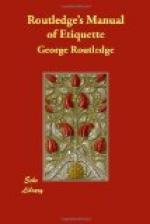WILD DUCK.
The choice part of a wild duck is the breast, which is cut in long slices from the neck to the leg. It is rarely the bird is required to be disjointed, but if it be necessary, it can be cut up like a fowl.
PHEASANT.
In the same manner in which you carve a fowl fix your fork in the centre of the breast; cut slices from the breast; remove the leg, which is considered excellent, in a line at 3, and the wing at 3, 5. To draw off the merry-thought, pass the knife through the line 6 beneath it towards the neck, and it will easily be detached. In other respects serve it in the same way as a fowl, the breast and thigh being most valued.
[Illustration]
GROUSE.
The first unrivalled bird of game, due on the 12th of August, breaking up the senate of the kingdom, and accessible only to the few whom wealth or privilege give the entree into the preserved regions, has, when even thrown into the market by the mercenary scions of the great, a considerable value; and perhaps it is only in the North that it is properly cooked and appreciated. A moor bird requires a particular sagacity in carving, which is a secret to the uninitiated. You may carve it like a common fowl; but the epicure alone knows that it is in the back that the true flavour of the heath is found, and in the North the back is recognized as the chief delicacy, and must be carefully proportioned among the guests.
PARTRIDGE.
The partridge is always well received in dinner society; and if the party be large and the supply of game small, the partridges must be jointed like a fowl, to make the most of them, but in a small party it is only necessary to fix the knife in the back, and separate the bird at once into back and breast, dividing it then according to the number of guests, always remembering that the back of a well-fed partridge is by no means a despicable morsel.
WOODSTOCK OR SNIPE.
The great peculiarity in carving the woodcock or snipe is, that the bird is not drawn like other birds, but roasted as it is plucked, suspended by the head, with a toast beneath, on which the trail, as it is called, or internal part, is allowed to drop; and when the birds are roasted, which should be rapidly done in twenty minutes, the trail should be spread over each toast and the bird served up on it. It is then only necessary to carve each bird through the breast and back, with its due proportion of the trail and toast. The best part, however, if carved, is the thigh.
PIGEONS.
As the pigeon is too small a bird to disjoint, it is the fairest division to cut it through the middle of the breast and back in two equal parts. Another mode is to insert the knife at 1, and cut on each side to 2 and 3, and forcing them asunder, to divide each portion into two; but this is not needed except in a large party.




